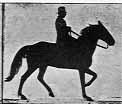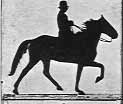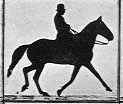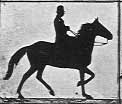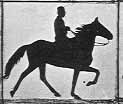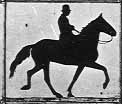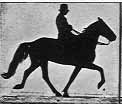

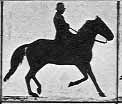
Amble in the horse The so-called "easy" gaits are generally four-beat and derived from the walk, but are faster, with support alternately on one and two legs, instead of two and three. Some horses amble with fairly even spacing between footfalls, and the horse illustrated below appears from the number of frames at each stride to be close to this. Footfall sequence is right hind, right front, left hind, left front. I believe all of the easy gaits - amble, running walk, foxtrot, rack, tolt, paso fino, etc. - have this same footfall sequence. However, some are evenly spaced and some verge more toward a pace (right hind followed immediately by right front, pause, left hind followed immediately by left front) while I think others lean more toward a trot (right front followed immediately by left rear, pause, left front followed immediately by right rear.) Differences also occur in the degree of collection, which affects the weight distribution between the front and the rear. Although the easy gaits are more comfortable to the rider than a sitting trot, and hence were gratly favored by riders from the Romans down to colonial Americans, I have to say that I found a tolt a good deal less comfortable than a posting trot. The easy gaits also create problems in riding with other horses, as their speed generally falls between a walk and a trot.
Many of the breeds which are capable of the easy gaits are natural pacers when moved at a trotting speed. They generally need some training to do the easy gaits rather than moving out at a pace.
The photographs shown were filled in because the horse did not contrast adequately with the background. There are small dots next to the right feet.



